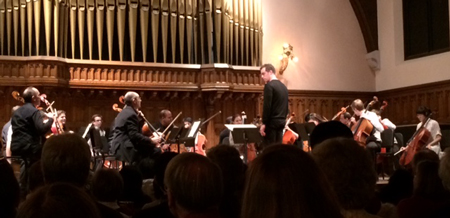by Carlyn Kessler

Harkness Chapel was filled to capacity with an audience of all ages, including many families, as well as other Cleveland Orchestra musicians supporting their colleagues. Bryan Dumm had researched and served as narrator for the program. In his opening remarks, Dumm noted that the concert would be a true celebration of the cello: with the exception of pianist Jee-Won Oh, all the performers were cellists and so were the composers, except for one. He described that the program aimed to display the “stories the cello can tell.” Dumm’s anecdotal dialogue, paired with the truly communicative nature of the music did just this: it welcomed the audience into the family of cellists while providing both intriguing “insider” information and historical background about the music.
The cello journey began with Martha Baldwin and Paul Kushious performing Domenico Gabrielli’s Canon, and Giacobbe Cervetti’s Divertimento No. 1, works that seemed to match the Neo-Gothic surroundings. The duo gracefully concluded with Martino Berteau’s Sonata de Camera, with Baldwin on the solo part and Kushious on the continuo. Dumm acknowledged that this piece is more commonly known as Italian composer Sammartini’s Cello Sonata, while it is a known fact among cellists that the work was actually composed by Berteau, who was French. “So,” he said, smiling, “I couldn’t resist listing Berteau as the composer in the program.”
Another duo, Charles Bernard and Ralph Curry, presented Boccherini’s Sonata in A Major, sharing the solo and continuo roles by switching parts throughout the piece. They did so seamlessly, most noticeably during the virtuosic, technically challenging “Allegro” movement. They matched each other with care and intention; with eyes closed, one would not have known who was playing each part.
The size of the ensemble grew for Wilhelm Karl Friedrich Fitzenhagen’s Concert-Waltzes for four cellos, performed by Mark Kosower, Richard Weiss, Charles Bernard, and Bryan Dumm, who switched roles from narrator to performer. The quartet’s sweeping, energetic sound conjured an operatic undertone. Kossower’s high, descending chromatic scale drew smiles from audience members, his effortless virtuosity reminiscent of a coloratura soprano. Like vocal male counterparts, the three other cellists gave warm support. Their united pizzicato chords resonated vibrantly through the hall.
The second half of the program traveled forward in time and took a stylistic turn, beginning with Spanish composer Gaspar Cassadó’s Requiebros (Spanish for “compliment” or “flirtation”). Weiss played with impeccable elegance, capturing the feisty nature of the piece by marrying his beauty of sound with a fiery vibrato. His energetic gusto was matched perfectly by Oh.
Brian Thornton joined Oh for Victor August Herbert’s Canzonetta. Dumm described Herbert’s contributions to musical theater, his passion for which was evident in Thornton’s performance. Thornton wonderfully captured the work’s tongue-in-cheek character, playing with a great ease and charming the audience with his musicality. Afterward, he motioned to Oh, beaming. “I think Jee-Won is the best cello accompanist of all time.” Thornton next played Piatti’s Caprice No. 1, which Dumm deemed “pure cello music.” Thornton quickly smirked at the audience before placing his last chord with a flourish, inspiring delighted applause and laughter.
Next came the infamously challenging Souvenir de Spa by Adrien-François Servais, performed by Kosower and Oh. Kosower embraced the challenge with gorgeous lyricism and sprightly virtuosity. The work’s charismatic French style was matched not only by his flawless performance but also by the smile on his face.
The friendship among the cellists of The Cleveland Orchestra was keenly felt throughout the evening. Each cellist was quick to join the audience after performing to watch their colleagues play. However, the bond of the cello section was most noticeably celebrated in a piece by Richard Wagner (the one “non-cellist” composer). His “Feierliches Stuck” from Lohengrin, arranged by cellist Friedrich von Grutzmacher, brought together the whole section.
The last piece, Julius Klengel’s Hymnus, op. 57 was performed by the TCO section, students of the Cleveland Institute of Music, and members of the Cleveland Orchestra Youth Orchestra, side-by-side, forming a 22-piece chamber orchestra conducted by Cleveland Orchestra bassist Charles Carleton. The cello is commonly viewed as closely connected to the human voice, in range and timbre. By such measure, this ensemble was reminiscent of a choir, resounding with an all-encompassing warmth that filled the chapel with a deep vibrancy. In unified sections, it was hard to believe that more than one cellist was playing, the blend so remarkably pure. Listening to the Hymn performed by this “choir” in an acoustically ideal chapel in front of an enormous pipe organ was akin to a religious experience and, indeed, felt spiritually transporting.
After concluding Klengel’s meditative work, all of the cellists on stage took a collective bow — against orchestral traditions — in a moving end to a magical evening of cello and camaraderie.
Photo by Carlyn Kessler.
Published on ClevelandClassical.com February 3, 2015.
Click here for a printable copy of this article



